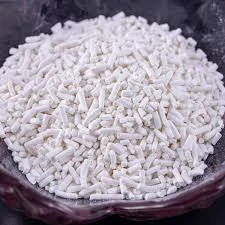
Natural Food Thickeners Enhancing Texture and Flavor in Cooking and Baking
The Role of Natural Thickeners in Food
In the world of culinary arts, the quest for the perfect texture can be as important as the quest for flavor. One of the key elements that chefs and food manufacturers consider is the thickening agent used in recipes. While synthetic thickeners can serve their purpose, natural thickeners have gained popularity due to their health benefits and clean-label appeal. This article explores various natural thickeners for food, their properties, and how they can be utilized in everyday cooking.
1. What are Natural Thickeners?
Natural thickeners are substances derived from plants, animals, or other naturally occurring materials that can increase the viscosity of food without altering its flavor dramatically. Unlike synthetic alternatives, which may contain additives or preservatives, natural thickeners offer a more wholesome option for health-conscious consumers.
2. Common Types of Natural Thickeners
There are several types of natural thickeners, each with unique characteristics and uses in the culinary world
- Starches Derived from plants like corn, potatoes, and tapioca, starches are some of the most widely used natural thickeners. Cornstarch is a mainstay in sauces and gravies due to its ability to create a smooth, transparent consistency when cooked with liquid. Potato starch provides a glossy finish and is often utilized in soups and fillings. Tapioca, with its unique chewy texture, is commonly found in puddings and bubble teas.
- Gums Various natural gums, such as xanthan gum and guar gum, are also employed as thickening agents. Xanthan gum, produced by the fermentation of sugars by the bacteria Xanthomonas campestris, is meant for those following gluten-free diets and is often used in salad dressings and gluten-free baked goods. Guar gum, extracted from guar beans, adds creaminess to ice creams and sauces, while also enhancing mouthfeel.
- Pectin Pectin is a natural thickening agent derived from fruits, particularly apples and citrus peels. It is widely used in the production of jams and jellies due to its ability to gel when combined with sugar and acid. Pectin can also serve as a thickener in dessert sauces and fruit preserves.
- Agar-Agar A vegetarian alternative to gelatin, agar-agar is extracted from red algae and can be used as a thickener in desserts, soups, and sauces. It sets at room temperature and is often employed in Asian desserts, such as jelly and puddings.
- Nut and Seed Butters Natural thickeners can also include nut and seed butters like almond butter and tahini. These not only thicken dishes such as smoothies and sauces but also add richness and a nutty flavor profile.
3. Benefits of Using Natural Thickeners
natural thickeners for food

- Healthier Alternative Natural thickeners are generally free of artificial additives and preservatives, making them a healthier option
. They often contain beneficial nutrients, such as fiber and antioxidants, contributing to overall well-being.- Versatility Many natural thickeners can be used in a variety of dishes, from savory sauces to sweet desserts. This versatility allows home cooks and professional chefs to experiment and innovate in the kitchen.
- Allergen-Friendly With the rise of food allergies and intolerances, natural thickeners can offer options suitable for various dietary needs, such as gluten-free or vegan diets.
- Flavor Enhancement Unlike some synthetic thickeners that can impart an undesirable taste, natural thickeners often complement the flavors of the dish, enhancing the overall taste experience.
4. Tips for Using Natural Thickeners
When incorporating natural thickeners into recipes, it’s essential to follow specific guidelines to achieve the desired consistency
- Know Your Ratios Each thickener has a different thickening power. It is crucial to understand the appropriate ratios to avoid an overly thick or too runny dish.
- Timing Matters Some thickeners, like cornstarch, need to be mixed with cold water before being added to hot dishes. Others, like agar-agar, must be boiled to activate their gelling properties.
- Test and Adjust It may take some experimentation to find the right amount of thickener for your recipe. Begin with a small amount, and gradually add more until you achieve your desired thickness.
Conclusion
Natural thickeners are essential ingredients in the culinary world, contributing not only to the texture of food but also to its overall appeal. Understanding the different types of natural thickeners available and how to use them effectively can elevate the quality of home-cooked meals and professional dishes alike. As consumers increasingly seek wholesome options, natural thickeners will continue to play a vital role in the future of food preparation.
-
Pure Sodium Dichloroisocyanurate Dihydrate | Powerful DisinfectantNewsAug.29,2025
-
Industrial Chemicals: Quality & Purity for Every IndustryNewsAug.28,2025
-
Nitrile Rubber Honoring Strict Production StandardsNewsAug.22,2025
-
Aspartame Ingredients Honoring Food Safety ValuesNewsAug.22,2025
-
Fertilizer for Balanced Plant NutritionNewsAug.22,2025
-
Cyanide Gold Processing with High Purity AdditivesNewsAug.22,2025
-
Formic Acid in Textile Dyeing ApplicationsNewsAug.22,2025
Hebei Tenger Chemical Technology Co., Ltd. focuses on the chemical industry and is committed to the export service of chemical raw materials.
-

view more DiethanolisopropanolamineIn the ever-growing field of chemical solutions, diethanolisopropanolamine (DEIPA) stands out as a versatile and important compound. Due to its unique chemical structure and properties, DEIPA is of interest to various industries including construction, personal care, and agriculture. -

view more TriisopropanolamineTriisopropanolamine (TIPA) alkanol amine substance, is a kind of alcohol amine compound with amino and alcohol hydroxyl, and because of its molecules contains both amino and hydroxyl. -

view more Tetramethyl Thiuram DisulfideTetramethyl thiuram disulfide, also known as TMTD, is a white to light-yellow powder with a distinct sulfur-like odor. It is soluble in organic solvents such as benzene, acetone, and ethyl acetate, making it highly versatile for use in different formulations. TMTD is known for its excellent vulcanization acceleration properties, which makes it a key ingredient in the production of rubber products. Additionally, it acts as an effective fungicide and bactericide, making it valuable in agricultural applications. Its high purity and stability ensure consistent performance, making it a preferred choice for manufacturers across various industries.





